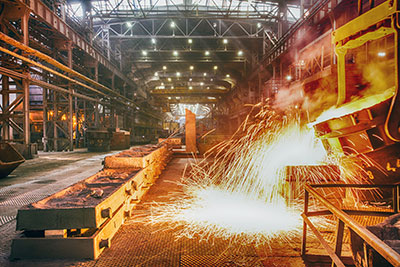Copper. Fire refining of blister copper.

Roughing
Copper, obtained in a wide variety of
Technological schemes is very
Good collector for most
Colored and especially noble metals.
Rough copper can contain up to 4%
Impurities that make it unsuitable for
Direct use
Consumers. Among the most frequent
The impurities present in it can
Be called S; Fe; Ni; Pb; As; Sb; Bi; Sn; Zn; Se; Te;
Au; Ag
Amount of both harmful and valuable
Impurities necessitate the
Its obligatory refining.
Refining
Blister copper for economic
Considerations consistently
two ways. First purification of copper
From a number of the most active impurities with
Their high content is conducted by the method of
Fire (oxidative) refining,
And then electrolytically.
Cleaning from harmful impurities first
Is carried out in the operation of a fire
Refining of blister copper. Fire
Or anodic refining is based on
The affinity of metals for oxygen. Impurities,
Possessing a higher affinity for
Oxygen in comparison with copper, are removed
In the slag or in the gas phase. Process
Is carried out in a periodic mode in
Stationary or rotary kilns.
There are three options for organizing
Refining of blister copper in industrial
Conditions.
- Both stages of refining are carried out in the same enterprise, where black copper is smelted. In this case, copper (oxidative) refining copper comes in a molten state from specially installed mixers (copiers) of smelting.
- Both refining stages are carried out at special refineries, to which copper is fed in ingots weighing up to 1500 kg. This technology requires a re-melting of the rough metal, but allows on-site processing of anode remnants of the electrolysis process and technological waste.
- Fire refining of liquid blister copper is carried out at copper smelters, and electrolysis of the anodes obtained in this way is carried out centrally at special enterprises.
The third
Blister copper refining option
At domestic factories
Apply.
Basically
Only electrolytic
Refining, but without prior
Purification of copper electrolysis becomes
Excessively expensive and cumbersome. Composition
And the quality of marketable copper produced
After the final electrolytic
Refining, must comply
The highest grade of copper containing not less than
99.99% Cu. At the same time it is regulated
Maximum content of 10 impurities
(Bi; As; Sb; Fe; Ni; Pb; Sn; S; O; Zn), which is summed
Should not exceed 0.01%.
Oxidative
Fire refining - the most
Common pyrometallurgical
Method of cleaning metals from impurities.
It is used in the preparation of Fe, Ni, Cu, Pb,
Sn
Copper and the subsequent oxidation of harmful
And excessive impurities by copper oxide, translation
Impurity elements in the form of oxides in
The gas phase or into the oxide (slag)
Phase, which does not dissolve in the metal.
The process is carried out in two stages:
The first oxidizing and the second
Regenerative.
Oxidizing agents
In the first oxidative stage of the fire
Refining are: most often
Gaseous oxygen, less often dioxide
Carbon, water vapor, are also used
Condensed oxidants. Oxide
Copper, dissolved in metallic copper
In the second stage it is very easy
Is reduced by gaseous
Reducing agents.


